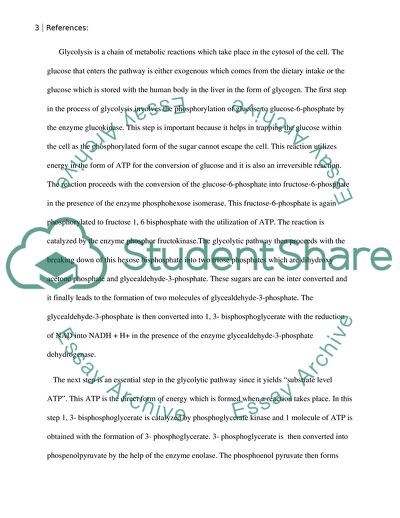
- Home
- Free Samples
- Premium Essays
- Editing Services
- Extra Tools
- Essay Writing Help
- About Us
- Studentshare
- Subjects
- Miscellaneous
- Glucose Metabolism and Energy Release Reaction
Glucose Metabolism and Energy Release Reaction - Essay Example

- Subject: Miscellaneous
- Type: Essay
- Level: Undergraduate
- Pages: 4 (1000 words)
- Downloads: 0
- Author: hollisblock
Extract of sample "Glucose Metabolism and Energy Release Reaction"
This substrate is glucose. Glycolysis is a cycle of metabolism which can take place in the presence as well as in the absence of oxygen. It is then referred to as aerobic and anaerobic glycolysis respectively. The utilization of oxygen occurs in those cells which have mitochondria. Cells which do not contain mitochondria utilize the anaerobic pathway. Glycolysis is a pathway which does not completely oxidize glucose but it actually involves the partial oxidation of the substrate. The energy provision is greater in cells in the presence of oxygen whereas the enrygy yield is low in the anaerobic state.
Certain cells which lack mitochondria are totally dependent upon anaerobic glycolysis. On the other hand other cells utilize aeroibic glycolysis but they can also resort to the anaerobic pathway. This occurs when the oxygen supply is low or in the case when immediate energy generation is required. An example is that of animal muscle cells which during periods of exercise start using the anaerobic glycolytic pathway. Glycolysis is a chain of metabolic reactions which take place in the cytosol of the cell.
The glucose that enters the pathway is either exogenous which comes from the dietary intake or the glucose which is stored with the human body in the liver in the form of glycogen. The first step in the process of glycolysis involves the phosphorylation of glucose to glucose-6-phosphate by the enzyme glucokinase. This step is important because it helps in trapping the glucose within the cell as the phosphorylated form of the sugar cannot escape the cell. This reaction utilizes energy in the form of ATP for the conversion of glucose and it is also an irreversible reaction.
The reaction proceeds with the conversion of the glucose-6-phosphate into fructose-6-phosphate in the presence of the enzyme phosphohexose isomerase. This fructose-6-phosphate is again phosphorylated to fructose
...Download file to see next pages Read More
- TERMS & CONDITIONS
- PRIVACY POLICY
- COOKIES POLICY